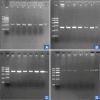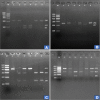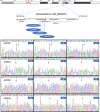LIPG SNPs, their haplotypes and gene-environment interactions on serum lipid levels
- PMID: 30621702
- PMCID: PMC6325827
- DOI: 10.1186/s12944-018-0942-y
LIPG SNPs, their haplotypes and gene-environment interactions on serum lipid levels
Abstract
Background: Maonan nationality is a relatively conservative and isolated minority in the Southwest of China. Little is known about the association of endothelial lipase gene (LIPG) single nucleotide polymorphisms (SNPs) and serum lipid levels in the Chinese populations.
Methods: A total of 1280 subjects of Maonan nationality and 1218 participants of Han nationality were randomly selected from our previous stratified randomized samples. Genotypes of the four LIPG SNPs were determined by polymerase chain reaction-restriction fragment length polymorphism, and then confirmed by direct sequencing.
Results: Several SNPs were associated with high-density lipoprotein cholesterol (rs3813082, rs2000813 and rs2097055) in the both ethnic groups; total cholesterol and apolipoprotein (Apo) A1 (rs2000813) in Han nationality; and low-density lipoprotein cholesterol, ApoB, triglyceride (rs2097055) and ApoA1 (rs3819166) in Maonan minority (P < 0.0125 for all after Bonferroni correction). The commonest haplotype was rs3813082T-rs2000813C-rs2097055T-rs3819166A (Han, 44.2% and Maonan, 48.7%). The frequencies of the T-C-T-A, T-C-T-G, T-T-C-G and G-T-C-G haplotypes were different between the Maonan and Han populations (P < 0.05-0.001). The associations between haplotypes and dyslipidemia were also different in the Han and/or Maonan populations (P < 0.05-0.001).
Conclusions: The differences in serum lipid profiles between the two ethnic groups might partly be attributed to these LIPG SNPs, their haplotypes and gene-environmental interactions.
Trial registration: Retrospectively registered.
Keywords: Endothelial lipase; Environmental factor; Haplotype; Lipids; Single nucleotide polymorphism.
Conflict of interest statement
Ethics approval and consent to participate
All procedures of the investigation were carried out following the rules of the Declaration of Helsinki, seventh revision (2013).The study design was approved by the Ethics Committee of the First Affiliated Hospital, Guangxi Medical University (No: Lunshen-2014-KY-Guoji-001; March 7, 2014). Informed consent was obtained from all participants.
Consent for publication
None applicable.
Competing interests
The authors declare no competing financial and/or non financial interests.
Publisher’s Note
Springer Nature remains neutral with regard to jurisdictional claims in published maps and institutional affiliations.
Figures






Similar articles
-
Association of the APOA1 rs964184 SNP and serum lipid traits in the Chinese Maonan and Han populations.Lipids Health Dis. 2018 May 10;17(1):105. doi: 10.1186/s12944-018-0759-8. Lipids Health Dis. 2018. PMID: 29747660 Free PMC article.
-
Association between the LIPG polymorphisms and serum lipid levels in the Maonan and Han populations.J Gene Med. 2019 Feb;21(2-3):e3071. doi: 10.1002/jgm.3071. Epub 2019 Feb 4. J Gene Med. 2019. PMID: 30657227 Free PMC article.
-
Association of the LIPG 584C > T polymorphism and serum lipid levels in the Guangxi Bai Ku Yao and Han populations.Lipids Health Dis. 2010 Oct 6;9:110. doi: 10.1186/1476-511X-9-110. Lipids Health Dis. 2010. PMID: 20923576 Free PMC article.
-
The role of endothelial lipase in lipid metabolism, inflammation, and cancer.Histol Histopathol. 2018 Jan;33(1):1-10. doi: 10.14670/HH-11-905. Epub 2017 May 25. Histol Histopathol. 2018. PMID: 28540715 Free PMC article. Review.
-
LIPG: an inflammation and cancer modulator.Cancer Gene Ther. 2021 Feb;28(1-2):27-32. doi: 10.1038/s41417-020-0188-5. Epub 2020 Jun 23. Cancer Gene Ther. 2021. PMID: 32572177 Review.
Cited by
-
The CXCL12 SNPs and their haplotypes are associated with serum lipid traits.Sci Rep. 2019 Dec 20;9(1):19524. doi: 10.1038/s41598-019-55725-3. Sci Rep. 2019. PMID: 31862910 Free PMC article.
-
Copy Number Variants in Four Italian Turkey Breeds.Animals (Basel). 2021 Feb 3;11(2):391. doi: 10.3390/ani11020391. Animals (Basel). 2021. PMID: 33546454 Free PMC article.
-
EHBP1 SNPs, Their Haplotypes, and Gene-Environment Interactive Effects on Serum Lipid Levels.ACS Omega. 2020 Mar 27;5(13):7158-7169. doi: 10.1021/acsomega.9b03522. eCollection 2020 Apr 7. ACS Omega. 2020. PMID: 32280856 Free PMC article.
-
APOE and KLF14 genetic variants are sex-specific for low high-density lipoprotein cholesterol identified by a genome-wide association study.Genet Mol Biol. 2022 Feb 21;45(1):e20210280. doi: 10.1590/1678-4685-GMB-2021-0280. eCollection 2022. Genet Mol Biol. 2022. PMID: 35238325 Free PMC article.
References
-
- Sperling LS, Mechanick JI, Neeland IJ, Herrick CJ, Després JP, Ndumele CE, Vijayaraghavan K, Handelsman Y, Puckrein GA, Araneta MR. The cardiometabolic health alliance: Working toward a new care model for the metabolic syndrome. J Am Coll Cardiol. 2015;66:1050–1067. doi: 10.1016/j.jacc.2015.06.1328. - DOI - PubMed
Publication types
MeSH terms
Substances
Grants and funding
LinkOut - more resources
Full Text Sources
Miscellaneous

